

 |
||||||||||||||||||||||
 |
||||||||||||||||||||||
|
||||||||||||||||||||||
Awards: Best High-Power IS Binoculars 2022
12x50's, 15x56's, and even an 18x56, you only need to look at the configurations of the instruments that I have been sent to review of late to spot that there is a real trend at the moment towards more and more powerful binoculars for general day-to-day use.
Indeed, if you needed further evidence of this, then the fact that Swarovski recently announced that they would be adding a 12x option to their latest flagship NL Pure series is it. Now I know that a 12x magnification is not exactly earth-shatteringly powerful, but the fact that a company like Swarovski with such a deep-rooted heritage and longstanding tradition is joining in to play with the "newer kids on the block" speaks volumes to me.
The Downsides to a High Power Binocular
It is a common misconception to those new to the world of binoculars to assume that the larger the magnification the better. This is completely understandable as the main purpose of the instrument is usually to provide you with a more detailed view of something in the distance.
But simply adding high magnification eyepieces onto binoculars brings with it many issues and there is most certainly a balancing act to be had and it is most certainly not the case of "bigger is better" and "one size fits all" and ultimately the right amount of power usually depends on your specific needs and requirements.
Image Shake - the nemesis of a highly magnified image
One of the biggest issues with looking at a magnified image through something like a binocular is that any movement made also gets magnified in the view.
Thus it quite quickly gets to the point (usually around 12x - 15x depending on the steadiness of your hands) that unless you do something to prevent the image shake, any potential increase in image detail offered by the higher magnification gets nullified by the tiny vibrations in the view.
Eliminating Image Shake
There are a few ways of reducing or eliminating the vibrations you see in the view, one is to fix the binocular onto a steady platform like a tripod and the other is to have some sort of dampening or image stabilization within the device itself.
Adding a tripod to most binoculars is usually very easy and does not need to be expensive. However, the downside is it turns "the unit" into a far more cumbersome device. This can be perfectly fine for setting up on your porch or in your garden and looking out to sea or at the stars but can get tiresome to carry about on a long walk.
Another less cumbersome option is to use a monopod, which works well, but still requires you to carry an extra piece of gear about.
The other option is an onboard image stabilization method that eliminates the need for a tripod, but comes at the cost of .. money, and whilst good, the level of stabilization has in my experience traditionally only been acceptable at best. That is unless you wanted to spend a whole bunch more money. Then there were other issues like battery life was often very short and so you had to carry about spares... blaa, blaa. To be frank, I personally lost interest in using IS binoculars and went back to my tripod.
However, time moves on and with improved technology and increased competition, we now have more options:
With these new APC Image Stabilised binoculars, Kite Optics look to me to be attempting to address the main issues with onboard image stabilization versus a tripod in that with a correction angle of 2°, the level of IS has been vastly increased (when compared to what I see as their main competition, the Canon IS binoculars), but at the same time, they have managed to keep the price to a level that whilst not cheap by any stretch of the imagination, would still be considered reasonable to the more serious users of binoculars, especially when you factor in the amount of tech that goes into making a set.
So with this all in mind and the fact that it has been a very long time since I've tested any IS binocular on BBR, I approached them to ask if they would be willing to send me a sample.
Also available in 10x30, 12x30, 12x42 configurations, I ultimately decided on the most powerful 16x42 version as I knew that if I found the image stabilization to be effective at this very high power, it would only be even better in the others.
Note: Throughout this review, I will be contrasting and comparing the Kite Optics APC binoculars against what I see as the two established, market leaders in the field. That being Canon with their IS binoculars and Fujinon with their Techno-Stabi and Stabiscope binoculars as I feel this will give us a good reference point from which to work from:
Contents:
The somewhat lengthy, unscripted, and somewhat rambling video above is of me unboxing and giving my very first impressions on the new Kite APC 16x42 Image Stabilised binoculars on the BBR YouTube channel, but I have decided to include it in with this review as I do feel that it provides a good insight for those who want to dive even deeper into what aspects like the packaging, accessories, the general shape and appearance of the binoculars as well as some of their main features.
Rather than beginning this review by going over the main body or optical features as I usually do, I think with these Kite APC binoculars I will address the elephant in the room that is the Image Stabilization and its effectiveness as this is most certainly the main reason to either buy or pass over this instrument for a standard pair.
Correction Angles
When I first looked over the main specifications, one aspect that immediately caught my eye was the stabilisation correction angle of 2 degrees on all models within the APC series.
This is impressive as depending on which model you go for, Canon IS binoculars can only counter between 0.7 and 1.0 degrees.
However, it must also be said that Fujinon Techno-Stabi and Stabiscope binoculars are able to correct between 3 and 6 degrees of motion.
Image Stabilization: Real World Use and Thoughts
These numbers are of course all good and well on paper, but to be honest, didn't really mean that much to me until I actually tried them out:
As I say, it has been a long time since I last tested a pair and since then the technology has moved on and I have to say, the first time I turned the Kite APC 16x42 binoculars on and looked through them I was blown away.
To handhold a 15x or 16x binocular is for me just about the maximum that I would consider, yes it is true that for testing I used the 18x56 Maven B5 binoculars from the hands, but as I stated in that review, this is only possible for very short periods of time and even so you are still sacrificing the extra image detail that you would see if it was somehow stabilized.
The difference in image detail that you can see really comes into sharp focus (excuse the pun) when you use these Kite APC 16x42 binoculars with the IS switched off and then keeping your eyes fixed on the view you turn it on. Whilst not 100% rock steady like being fixed to a tripod, the image goes from being juddery to what I would describe as being very steady, almost like you how I would imagine being a bubble in a spirit level would feel. So all movement is dampened, with the result being the small image shaking is eliminated, and hey presto, you can now once again enjoy the extra image detail that the 16x magnification offers.
Rather than me continuing on and using more words to try and describe the effectiveness, you will get a far better idea if you take a look at the video I made below:
So as you can see, whilst it is not 100% rock steady like a binocular mounted onto a tripod, it is still night and day when compared to the view with the IS turned off.
Also do keep in mind that in this video I was holding the binoculars in a fairly awkward position and in order to get a full picture view, I had to increase the optical zoom on my camera and thus the view you get through your eyes when holding it up to your face is generally even steadier, both with and without the IS enabled.
Unfortunately, I can't compare this footage directly with any of the Canon or Fuji instruments as I don't have any with me (I'm working on it), but from memory, I have to say I feel far more impressed using these than the Canon that I tested some years back, which for me was slightly underwhelming.
Although to be fair, the model I tested was the 10x30, and thus image stability is not as much of a factor and thus the difference it makes when you turn it on is not as noticeable.
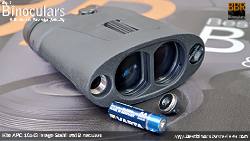 Power
PowerIn this modern world where everything is connected and powered, it is nice to sometimes get away from all that and not have to worry about start-up times, battery life, and charging, and so for me, this has always been one of the big appeals of standard optic only binoculars and a reason why I have tended to shy away from powered Image stabilized binoculars, which in my experience often have relatively short battery lives.
Well, the Kite APC 16x42 Image Stabilized Binoculars are powered, but Kite Optics has obviously put a lot of thought into how to make it as less painful as possible by addressing the issues:
Indeed, as the APC in their name suggests, this is one area in which Kite are particularly proud of them:
APC (angle power control) System
Once you have set the power switch to the on position, you no longer have to worry about turning the device on and off all the time as these Kite APC binoculars will automatically switch to a sleep mode when pointed directly downwards like for instance when hanging from your neck or when you place them onto a tabletop.
This is a feature that I really do like as not only does it certainly contribute to extending the life of the batteries, but not having to constantly turn the IS on and off makes it one less thing you have to worry about in the field and you can just get on with enjoying the view as you would with a standard set of optics.
One potential downside to this feature is if you wanted to specifically look directly downwards like you were on a cliff face or tall building for example. I tested this and the IS will only switch off one the device is near vertical, so I imagine the number of times you would want to use binoculars in this position would be quite rare, but even so, it would be nice to have a way to turn this auto APC feature off.
Also if you were wondering, pointing the binoculars straight up (like you would for astronomy, plane spotting, or perhaps viewing birds on the wing), does not put them into sleep mode.
Batteries & Battery Compartments
All Kite APC binoculars are powered by 2x AA batteries, making them easy enough to get hold of.
The binoculars themselves are actually able to carry 4x AA batteries and they have two separate battery compartments positioned on each side of the instrument and accessed via a small twist-on/off cap located on the front next to the objective lenses.
As the binoculars are fully waterproof, the caps have seals on them and the compartment is spring-loaded, which helps with removing batteries, but until I got used to it, did make it a little tricky to replace the cap the first few times I tried.
You only need to carry 2 batteries as the compartment on the right is only there to carry spares, what the one on the left is where the power is drawn from.
Note: I did have a comment on YouTube from someone who watched my unboxing video who mentioned that the position of the battery compartment, next to the objective lenses was a problem as there was an increased potential for you to damage the lenses when swapping out batteries.
This is not something I had initially thought of, but he may have a small point here and I would just advise that you are extra careful when changing batteries to make sure you don't drop them against the glass.
Battery Life
The APC system certainly contributes to extending battery life on these Kite APC 16x42 Image Stabilized binoculars, but even so, the stated 60 hours per set (or 120 hours if you carry spares onboard) is seriously impressive:
Canon also uses 2x AA batteries to power their IS binoculars, but they omit to mention battery life, which is somewhat suspicious, but I have read that depending on the quality of the batteries used, it can be as little as two hours. I am not sure how true this is, as my experience in using them was a little better than that, but as I say that was a long time back now and the instrument has gone through a number of iterations since then.
Fuji Techno-Stabi binoculars are powered using 4x AA batteries, but also fail to mention how long you can expect them to last and as of yet, I have not been able to find out any further information on them in this regard.
Note: At the time of writing this review, I have used and tested the Kite APC 16x42 Image Stabilized Binoculars extensively, and whilst I may not as yet clocked up 60 hours, the batteries that Kite supplied me with the sample (not sure if they were new) are still working perfectly fine.
Kite does not go into much detail at all when it comes to the specific coatings and glass used on the lenses and the prisms, so I can't elaborate much here, but what we can take a look at is the rather unique 16x42 configuration and how in theory this affects the view and overall performance, then later on, in the Image Quality section, I will also discuss how this theory pans out in the real world:
Combining very typical and "standard" sized 42mm objective lenses with a very untypical, and very powerful 16x magnification is interesting and throws up a number of positive and negative aspects, which I think are important to understand in order to decide as to if this version of the Kite APC is most suitable to you or one of the less powerful models in the series:
Image Quality & Brightness
In order to create more powerful magnifications, you need to use thicker glass elements within the lenses, this, in turn, means less light is able to pass through them, which results in a less bright image.
Now there are many other factors that come into play here and to be fair the differences we are talking about here are very minimal, but I feel it is worth pointing out nonetheless.
Low Light Performance
Increasing the power without increasing the size of the objective lenses results in smaller exit pupil diameters (the size of the shaft of light exiting the ocular lenses).
With smaller exit pupils, you have to be more precise when lining up your eyes with them to make sure you don't get any black rings forming around the edges of the view and in low light conditions when the pupils in your eyes are dilated, it can make for a less bright image when compared to an equal quality binocular with larger exit pupils. For more on this, please take a moment to read my complete guide to the exit pupil.
So a "standard" 8x42 binocular that is generally considered a good all-rounder and fairly decent option in low light produces a 5.25mm exit pupil (Objective lens size (42mm) divided by the magnification (8x)).
In sharp contrast, these 16x42 binoculars deliver a much smaller 2.6mm exit pupil (42÷16).
If you consider that in very low light, the maximum size that your pupils can grow to is 7mm in diameter (this reduces as you get older), then you can understand that these relatively small shafts of light exiting the binocular mean that the binocular is not able to supply your eyes with enough light and thus you perceive a less bright image.
So if you know you will be using your binoculars a lot in low light, these may not be the right choice and unless you specifically require the higher power, you may be better of with the 12x42 configuration instead.
At 42mm in diameter, the size of the objective lenses used in these Kite APC 16x42 Image Stabilized binoculars is very typical for a "standard" sized instrument. However, as you can see from the photo above what is not typical is just how close they are positioned together.
I will assume the reason for this was to also fit in the extra bits needed for the image stabilization.
In theory, wider set lenses produce a better stereoscopic image and thus potentially a better feeling of depth to the view.
With the very high 16x magnification, the depth of view is already very difficult to compare against more typical 8x, 10x or even 12x instruments, but I would like to add that whilst using them I never felt that the depth of view was particularly shallow, so I wouldn't worry too much about this aspect.
As mentioned earlier, Kite Optics does not at all mention what coatings they use on either the lenses or the prisms and thus I cannot comment or indeed score them in this section, which is a real shame.
Anyway, I have reached out to them and as soon as I get any information I will include it here.
Optical Components Quality Rating: Unknown
Field Of View (FOV)
Whilst you get more image detail, one of the negatives to high magnifications is the more zoomed-in image results in a narrower field of view. Depending on how or what you are using the binoculars for this may or may not be a big deal.
I will get to that in a moment, but first, let's take a look at the figures and compare them:
These Kite APC 16x42 Image Stabilised binoculars have a field of view that is 68 meters wide at a distance of 1000 meters away (roughly 204ft @ 1000yds).
In comparison, the lower-powered Canon 15x50 is 79 meters wide (approx 237ft), whilst the more powerful Canon 18x50 has a narrower field of view at 65 meters wide (approx 195ft) which is what you would expect. The Fujinon TS 16x28 with the same power is very similar to the Kite at 70 meters wide.
As you can see in the table below against other similarly powered binoculars that I have tested the FOV of these is pretty much as to be expected, whilst you will also notice that against lower 10x binoculars, the FOV is quite a bit narrower (and even more so when compared to 8x instruments), which is to be expected.
At close range, a high power and narrow field of view make it more difficult to quickly locate and follow small, fast-moving objects, and thus if you intend on using these binoculars often in places like forests for birding then this model would perhaps not be the ideal choice.
For more static or larger slower moving subjects this is not such a big deal and it can be quite nice to appreciate the extra detail that these provide over a lesser-powered device. But it is out in the open like at the coast, fields, or rolling hills where observation distances are generally greater, where ten the extra reach and detail that these provide outweigh the narrower FOV and these come into their own.
Minimum Focus Distance
Whilst not generally designed for close range, it is still nonetheless interesting to compare the minimum focusing distances between these and other similar instruments as I say it can be really interesting to enjoy the extra detail on things like flowers or even butterflies that the higher power provides.
At 4m / 13.0ft the minimum focus on these Kite APC 16x42 Image Stabilized Binoculars is pretty good for a high powered instrument which can be seen in the table above, and this trend continues against their main competition:
Eye-Relief:
Greater eye-relief is of most importance to those who need to wear glasses or other forms of eye protection when using their binoculars. See How To Use Binoculars With Glasses: Eye-relief & Eye-cups Explained.
As a rule of thumb, I usually recommended that eyeglass users look for a minimum of 15mm (preferably more) of eye-relief to be sure that you can see the full image without black rings on the edges after you have fully twisted down the cups.
So at 14mm, these fall just short of that. I did test them using my glasses and whilst not as easy to use as longer eye-relief instruments, I was personally able to view the full image with a problem as long as I pushed my face and glasses fairly firmly against the eyecups.
If you are worried about this and you very often or always need to use glasses, then you could instead opt for the 12x42mm Kite APC binocular which comes with a much longer 17mm of eye-relief.
Optical Stats Score (15x-20x Bins): 7/10
I have now had just about 3 weeks of testing these Kite APC 16x42 image-stabilized binoculars under my belt and as such, I have where I have used them in a wide range of conditions that includes sunny, very low light, and even complete darkness for astronomy. And whilst I have not been able to compare the view against any other IS instruments, I have used them alongside a number of other instruments, ranging from my standard 8x42 and 10x42 benchmarks, right up to 15x56and 15x70 binoculars, and below are my thoughts and observations:
Image Shake
As I have already covered this in the Image stabilization section above, I won't dwell on this aspect of the view too much here, but I do think that it is worth reiterating just how effective the IS is and what a difference it makes to the overall quality of the view.
With it turned off, yes you can "see" yes, but because of the shake, you really do miss a lot of detail in the image. This effect is especially noticeable when using them for something like astronomy and viewing the moon where as soon as you switch the stabilization on you can immediately notice far more of the markings on the moon's surface and these get very close to matching a large 15x70 fixed to a tripod.
Color Reproduction
Here I was very impressed and whilst I don't know the level of optics used in these, the overall color reproduction is vibrant, yet looks true to life. So
Also at no time did I ever notice any unwanted tinting or discoloration of the image which you can sometimes see, especially on higher-powered instruments.
Contrast
As with the colors, the level, and range of contrast to me when looking through these Kite APC 16x42 Image Stabilized Binoculars is excellent meaning that you get a good variance between the dark and light areas, which adds to the sense of depth to the view.
Image Brightness
With good sized 42mm lenses, and what I assume is a reasonably high level of glass and coatings, I was expecting the image in good light conditions to be bright and I was not to be disappointed. Indeed of a high power instrument, I was very pleasantly surprised with just how bright the view was.
However, the combination of 42mm lenses and the 16x magnification produces relatively small 2.6mm exit pupils (42/16), which indicates that in low light when your pupils are dilated to a size larger than the exit pupil, these will most likely look less bright than equal quality binoculars with a larger exit pupil.
That is the theory, in practice, I found that in dull overcast conditions during the day and even on wet rainy days, the image these produced looked surprisingly bright to me and was not that dissimilar to a 15x56 and whilst not quite as bright, not very far off the 15x70 binoculars that I compared them against which was surprising.
Indeed it was only in what I would describe as very low light conditions like as the sun was setting that there was a noticeable drop off in performance which becomes more noticeable the darker it gets. This is totally understandable considering the difference in lenses and exit pupil sizes.
When it comes to Astronomy and looking at objects like the stars, planets, or the moon, it gets even more complicated as instead of looking at a dull object in very low light, you are now looking at bright shiny objects, but in the dark:
So here, even though the exit pupil is smaller, you do much more detail when looking at the moon with this 16x magnification when compared to something like an 8x or 10x binocular. Here the image stabilization really helped as well.
Against my 15x70 astronomy binoculars mounted on a tripod, objects like the moon and bright stars are not dissimilar, but with their larger lenses that can capture more light, the 15x70 is better at detecting less bright objects in the night sky. Even so, if you do get a pair of these Kite APC 16x42 image stabilizing binoculars, I highly recommend pointing them up to the night sky every now and then.
Color Fringing
 The higher the image is magnified, the more pronounced color fringing generally becomes, so yes compared to a high-end 8x42, these Kite 16x42 binoculars do show a fraction more but it is not what I would consider being excessive and against my higher powered Astro binoculars, they compared very well.
The higher the image is magnified, the more pronounced color fringing generally becomes, so yes compared to a high-end 8x42, these Kite 16x42 binoculars do show a fraction more but it is not what I would consider being excessive and against my higher powered Astro binoculars, they compared very well.
Image Flatness
This is another area where these performed very well as once you have focused on an object, it remains sharp and in focus from the center all the way to the edges of the view. For a high-power binocular where image detail is of even greater importance than ever and your overall field of view is reduced, this is very important.
Softening
Another definite strength to these Kite APC 16x42 image stabilising binoculars is just how little blurring there is right at the edge of the view.
Image Quality Rating: 8/10
Shape & Design
I have to say that I am a huge fan of the overall shape and design of these Kite APC binoculars and to simply state they are comfortable in the hands is truly an understatement.
You can tell that someone has put a good deal of thought into coming up with this shape to make sure that it is right. For some, this may all seem rather trivial, but I find that a comfortable binocular is not only more of a joy to use, but it also makes it easier to keep the image still and thus undoubtedly improves the stability of the view even further.
Inter-Pupillary Distance (IPD) Adjustment
One aspect to these that takes some getting used to is not having a central hinge to open and close to make adjustments to the distance between the eyecups.
I use binoculars so much that during testing I would often find myself trying to open and close a non-existent hinge! Instead of this normal method, with these Kite binoculars and indeed most other IS binoculars, the actual eyepieces are adjustable.
Is this method as simple or robust as that on a standard pair of binoculars? Not quite, but I have to say that the mechanism felt solid and very well made.
You have to use a fair amount of force to move the eyepieces, which is a good thing as you would not want to have to keep re-adjusting them because they move by accident all the time.
The actual interpupillary range on these is between 5.4cm and 7.4, which for a full-sized binocular is pretty standard.
Rubber Exterior
The rubber that covers most of the exterior surface is relatively thin and thus will not provide as much impact protection as a softer thicker rubber.
However, it is very tactile and does provide a high level of grip. Indeed it kind of has a velvety feel to it which only adds to the feeling of comfort and quality, although it also definitely attracts dust, which for me was an issue when I came to take the photos for the review!
Environmental Protection
I was pleasantly surprised when I discovered that the Kite APC binoculars are fully sealed and have a recognized IPX 7 rating meaning that they can be submerged in 1 meter of water for 30 minutes and remain watertight.
This is impressive as I know that this is certainly not the case on all of the Canon IS binoculars.
This may seem like a small thing, but remember a fully sealed device is also protected from dust in dry weather conditions and the image stabilization feature is ideal for use on a boat as well as in windy conditions by the coat where you are bound to have some sort of rain or sea spray.
Fogproof
As well as being waterproof, Kite has also filled the interior with dry nitrogen gas that unlike standard air will not condense and form droplets on the internal lens surfaces when you get a rapid temperature change like going outdoors on a cold winter morning.
Correct me if I am wrong here, but I think I am right in stating that only one model within the Canon IS series (the 10x42 L IS WP) is both water and fogproof?
Eye-Cups
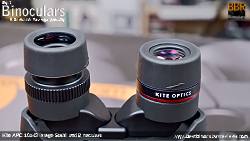 The helicoidal screw-up/down eye-cups are very good on these Kite APC 16x42 Image Stabilised binoculars:
The helicoidal screw-up/down eye-cups are very good on these Kite APC 16x42 Image Stabilised binoculars:
The mechanism on my sample was very smooth and whilst there was some free play between the cup and the housing underneath, it is only a tiny fraction and then this was only at the mid-click-stop positions, which is typical and nothing at all to worry about.
I do like the way the cups click very positively into each of the stops. Speaking of which there are two mid-position stops, which if you include the maximum and minimum positions makes four in total which is excellent and offers plenty of customizability to suit your shape of face and achieve the ideal fit in terms of eye-relief.
The only downside to me is that unlike very high-end binoculars, they cannot be unscrewed and removed. This is not a huge deal, but it does help with ocular lens cleaning and makes it easier to replace should you need to.
Focus Wheel & Focusing
The focusing "wheel" ( it is more like a barrel) is very different from that which you find on a typical set of binoculars.
Whilst still located along the central line of the binocular (which is good for both left and right-hand use), its position is quite a long way forward which meant that I did find myself often changing the focus with my middle two fingers instead of my index finger. This was neither good nor bad, just different.
Measuring 4cm, it is almost twice as wide as that found on most binoculars and so is very easy to locate.
However, it also has a much smaller radius, and thus has a low profile, which looks great and perfectly fine for most of the time, but whilst wearing my thick woolen gloves was just that bit more difficult to locate and turn.
The fact that it is so long, and the fact that the mechanism itself is extremely smooth, offsets this issue somewhat, but even so I would have preffered a higher profile adjuster.
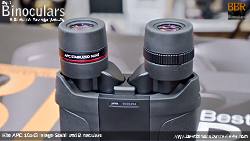 Diopter Adjuster
Diopter Adjuster
Located on the right eyepiece, you use the diopter adjustment ring to calibrate your binoculars by off-setting the focus on just one eye.
This works well enough and you get a very respectable +/- 3 points of dioptric compensation and so the only point I would make would be that it would have been even better if Kite had made it lockable, which is a feature you sometimes see on high-end binoculars so as to ensure you don't accidentally move from your setting.
Not Tripod Adaptable
Yes, I know the whole idea of the IS on these is to remove the need of having to use a tripod, but even so, there are examples where you may want to mount my binocular onto a tripod:
It is a good way to be able to share a view with someone else (this is useful for astronomy) also target shooters/archers who generally want a high power instrument like this who like to be able to take a shot and then check for positioning.
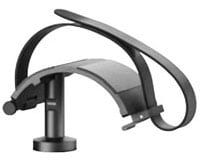 So yes, I'll admit that I am nit-picking quite a lot here and to be fair only a very small proportion of users will want this feature, but even so it would have been great had there been a tripod mounting thread somewhere.
So yes, I'll admit that I am nit-picking quite a lot here and to be fair only a very small proportion of users will want this feature, but even so it would have been great had there been a tripod mounting thread somewhere.
Also, if you do need to mount these onto a tripod, there are other methods, like the Zeiss Universal Binofix adapter which should work well enough. You can find these and other designs here: tripod adapters.
Body Construction Quality: 8/10
Dimensions
Whilst a little bit longer and a different shape/feel to them, the outer dimensions of these Kite APC Image Stabilized binoculars is not that dissimilar to that of your typical optics only 42mm binocular:
Comparing them to some of the other image stabilising binoculars on the market in the table below, you can see against the 10x42mm Canon IS, the Kite is a little longer, but substantially thinner, which is one of the main reasons as to why I found them so comfortable to hold in the hands.
As you would expect they are quite a bit smaller than the Canon 50mm options in every way and a little larger than the "mid-size" 30 - 36mm options out there. In general, the Fujinons are the least compact of the most well known IS instruments currently on the market in all the different size categories:
Weight
Whilst comparing the different dimensions between these Kite APC 16x42 Image stabilized binoculars against standard binoculars and indeed against their competitors in the IS arena is interesting because by not using a tripod, you will be taking all the strain in your hands and arms instead.
For short periods, a heavyish binocular is not an issue for most people, but for long periods and especially at awkward angles, like when pointing upwards in the sky for astronomy/plane spotting or viewing birds on the wing, it can get surprisingly tiring quite quickly.
Without batteries, the Kite APC 16x42 binoculars are about the same weight as most good quality standard 42mm binoculars, and even with two batteries installed, using them did not feel at all different from using a normal pair of high-end binoculars, which is great.
As you can see above, the equivalent sized (40 - 42mm) Canon and Fujinon are both far heavier, and even more so if you want to get a 15x or 18x option.
So yes, the 50mm Canon's will have a better low light performance, but they are much bigger and heavier and so this is one of the choices you will need to make when deciding which is best for your needs.
Body Stats Score (40 - 42mm Image Stabilized Bins): 9/10
As I have become accustomed to when testing instruments from Kite Optics, the standard of the included accessories that comes with this APC model is excellent:
Note: Because I have already covered much of these in the unboxing video at the top of this review, I will keep this brief and just list the main features, highlights, and any weak points:
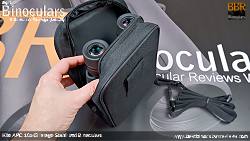 Carry Case
Carry Case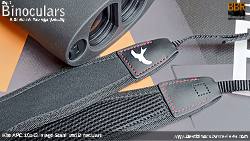 Neck Strap
Neck StrapThe Kite neck strap is the same one as which you get with their top-end Kite Lynx HD+ 10x50 Binoculars that I reviewed not that long ago which is great news as it is generally excellent:
Like the case, it looks extremely well made with excellent quality materials and stitching. It is also very well-padded and slightly curved to fit more naturally around your neck and shoulders making it very comfortable to use.
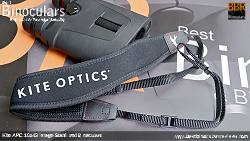 The thinner un-padded sections look to me to be made from a nylon material and without testing to destruction, they look to me to be connected very securely to the padded section. Here some of the best use a ring that allows for a little more free movement of the thin straps as you move the binocular up to your eyes and thus the padded section remains undisturbed. Admittedly it is a very minor detail, but thought it was worth mentioning.
The thinner un-padded sections look to me to be made from a nylon material and without testing to destruction, they look to me to be connected very securely to the padded section. Here some of the best use a ring that allows for a little more free movement of the thin straps as you move the binocular up to your eyes and thus the padded section remains undisturbed. Admittedly it is a very minor detail, but thought it was worth mentioning.
Lastly, the strap attaches to the binocular in the normal way by looping it through the eyelets on the sides of the instrument and back on itself via a slider that enables you to adjust the length.
This tried and trusted method works perfectly fine, but I do appreciate straps that come with extra quick release clips that enable you to quickly remove the strap and/or attach it to a binocular harness if you wish.
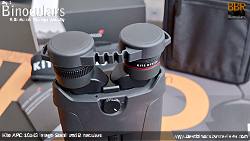 The ocular lens cover (rain-guard) is of a very typical design and of all the accessories is the most generic looking.
The ocular lens cover (rain-guard) is of a very typical design and of all the accessories is the most generic looking.
Still, it gets the job done and fits very well onto the ends of the eyecups and so should not come away too easily by accident.
I like the flexible bridge meaning that it can be attached no matter what you have set your IPD. There are plenty that miss this detail and it gets annoying having to open and close the binocular every time you want to use and replace it.
My sample did not come with any, but Kite have told me that they are already being produced and from early next year all units will be equipped with ojective lens covers.
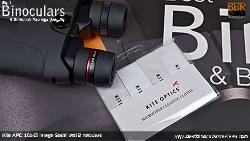 Cleaning Cloths
Cleaning Cloths
The cleaning cloth, or should I more correctly say the whole set of cleaning cloths that you are supplied with are truly excellent and certainly a welcomed and very useful addition.
Instead of the normal token and usually reasonably low-quality cleaning cloth, the Kite binoculars that I have tested all come with a set of five Kite Optics branded, very high-quality microfiber cleaning cloths that are specifically designed to remove greasy fingerprints, oil, dust, and dirt from the lens surfaces.
Whilst I would still suggest you invest in an optical lens cleaning kit for a thorough cleaning, these cleaning cloths will be more than adequate for general day-to-day use.
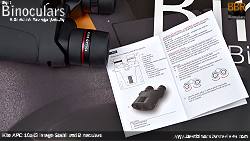 Manual
Manual
Kite optics includes a chunky instruction manual with the instrument, but this is written in several languages so is not quite as in-depth as you would first have thought when picking it up.
Anyway, it covers all the basics including naming all the parts of the instrument, inserting batteries, using the image stabilisation system, IPD settings, and setting up the binocular as well as basic cleaning and storage.
Warranty
Kite Optics includes a 30-year warranty on the binocular, with 2 years for the electronics.
Extras Rating: 7/10
The effectiveness of the image stabilization on these Kite APC 16x42 binoculars far exceeded my expectations and I have to say that I am extremely impressed with them in this regard.
The image quality as a whole was very good to excellent: When focussed, the image is sharp right to the edges of the view with good contrast and vibrant colors. I also thought that for a powerful 16x binocular, the relatively small amount of color fringing was impressive.
Likewise, I found the overall build quality to be excellent (imagine a high-end camera), which along with a very well-thought-out body design makes them extremely comfortable to hold. Add to this all the small attention to detail like the auto sleep function when you point them downwards they all add up to making this instrument truly a joy to use and one I have absolutely no hesitation in recommending for use in the right situations (see ideal uses below).
Size and weight are comparable to a traditional unstabilised 42mm binoculars which is impressive for an IS binocular as they are far more lightweight and indeed smaller than the competition in this class.
The fact that they are are waterproof is another definite strength especially when you consider this something that you only find on a couple of the more expensive Canon models.
As usual with Kite, I found the level of the included accessories like the carry case, neck strap, and cleaning cloths to be excellent.
Cost
The range of Canon IS binoculars will set you back anywhere between $400 and $150, but to compare apples with apples, if you want a high powered IS Canon binocular, you usually need to spend just over $1300.
The Kite APC 16x42 currently retail for around 950 euros, or just over $1000 and I assume over time this will come down, and so not only are they less expensive but at 2 degrees, they offer at least double the amount of IS correction compared to the Cannon's.
Fuji with their Techno-Stabi and Stabiscope binoculars can correct between 3 and 6 degrees of motion, but if you want something with a similar magnification, you will either need to spend close to $5500 to get the Fujinon 16x40 S1640D Stabiscope, or the alternative is the Fujinon 14x40 TSX1440 Techno-Stabi that currently costs about $1400.
With 8 degress of correction, Fraser Optics and their range of Stedi-Eye Gyroscopic Image-Stabilized Binoculars are seriously impressive, but come with an equally impressive price tag as they will cost you almost $4200.
So whilst in no way would I describe these Kite APC binoculars as being inexpensive, I do feel that if you are serious about reducing the amount of image shake in the view, then they are attainable and offer a good level of IS per dollar spent compared to other options.
Note: If you need a less expensive high powered binocular, then at this moment in time, rather than looking for cheaper IS options which will only disappoint I would rather opt for combining a reasonably good quality tripod with something like the Vortex Diamondback HD 15x56 as a good example of a good value high power instrument.
At first glance, the list of "weaknesses" below may look lengthy, but most are quite nitpicky and none are deal breakers, in my opinion. Others pertain to the 16x42 configuration as a whole and not this particular device, if any of these are a problem, I would suggest taming down a little and going for the 12x42 model instead.
I really like the focus wheel in terms of how smooth it is to turn and that it is nice and long making it easy to use... except when wearing thick gloves. Whilst not bad, I personally would have preferred it to have a slightly higher profile to make it just a little more obvious to find whilst wearing thick winter gloves.
Aspects like the slightly narrow field of view I guess could be described as a weakness, but only if you compare them to a lower-powered instrument as they compare very well against instruments of similar power. So if this is an issue for you, rather select a binocular with a lower magnification.
For 99% of users, Kite's APC (angle power control) system on these will be a strength and an excellent feature, but for that 1% who need to use the binocular looking straight down (perhaps search and rescue from a plane where the IS would be useful, or from a cliff top), then it will be a pain and it is just a pity that it can be disabled if needed.
General Long Range Observation
Be that for looking out to sea at passing ships, plane spotting, soaring eagles on the wing, or wildlife in distant valleys, if you need a standard-sized binocular to get you close to the action with increased image detail then you will struggle to find a more suitable instrument. This is especially true if you would rather not have to fix your binocular onto a tripod.
Also Good for:
 Awards:
Awards:Best High-Power IS Binoculars 2022
Main Specifications & Features:

General Price Range: (5/6) High Value Binoculars
Below is a link that will take you to a page with online retailers in both the US and UK that sell Kite 16x42 APC Binoculars this page makes it easy to compare prices and then to buy from your preferred option:
|
Buy & Compare Prices for the Kite 16x42 APC Binoculars |
||
US Shoppers |
Canadian Shoppers |
UK Shoppers |
Deutsch Shoppers |
Aussie Shoppers |
Indian Shoppers |